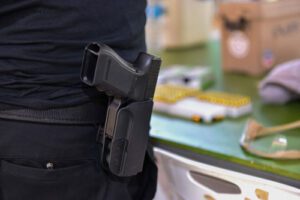 Judge Bumb continued: A similar flaw exists with respect to the Missouri statute cited by Defendants. Mo. Rev. Stat. 1879, at 224 (§ 1274). [Id., Ex. 10.] Although the 1879 Missouri law prohibited concealed weapons in “any other public assemblage of persons met for any lawful purpose,” the statute was explicit that the statute did not apply to “persons moving or traveling peaceably through [the] state,” and that “it shall [be] a good defense to the charge of carrying such weapon, if the defendant shall show that he has been threatened with great bodily harm, or had good reason to carry the same in the necessary defense of his person, home or property.” Id. § 1275. The Bruen Court recognized that several like jurisdictions codified narrow exceptions to, but generally permitted open carry, including Tennessee. Bruen, 142 S. Ct. at 2147 (explaining that the Tennessee Supreme Court in 1871 interpreted its laws to “permit the public carry of larger, military-style pistols because any categorical prohibition on their carry” would violate the right to bear arms) (citations omitted). Thus, the Court has doubts that the Tennessee statute cited by Defendants actually restricted firearms in the way that Defendants contend.
Judge Bumb continued: A similar flaw exists with respect to the Missouri statute cited by Defendants. Mo. Rev. Stat. 1879, at 224 (§ 1274). [Id., Ex. 10.] Although the 1879 Missouri law prohibited concealed weapons in “any other public assemblage of persons met for any lawful purpose,” the statute was explicit that the statute did not apply to “persons moving or traveling peaceably through [the] state,” and that “it shall [be] a good defense to the charge of carrying such weapon, if the defendant shall show that he has been threatened with great bodily harm, or had good reason to carry the same in the necessary defense of his person, home or property.” Id. § 1275. The Bruen Court recognized that several like jurisdictions codified narrow exceptions to, but generally permitted open carry, including Tennessee. Bruen, 142 S. Ct. at 2147 (explaining that the Tennessee Supreme Court in 1871 interpreted its laws to “permit the public carry of larger, military-style pistols because any categorical prohibition on their carry” would violate the right to bear arms) (citations omitted). Thus, the Court has doubts that the Tennessee statute cited by Defendants actually restricted firearms in the way that Defendants contend.
In any event, this statute prohibiting deadly weapons in any “fair, race course, or other public assembly of the people” is not sufficient to establish a tradition of banning firearms in the broad number of locations set forth in Section 7(a), subpart 17 of the statute. See 1870 Tenn. Pub. Acts 23. This leaves only Defendants’ citation to a New Orleans law prohibiting weapons in public ballrooms. [State’s Br. at 29 (citing Gen. Digest of the Ords. & Res. of the Corp. of New Orleans 371 (1831)).] Indeed, there appears to be many differences between the public ballrooms of 1831 and modern-day concert venues and amusement parks. Still, “one example does not a tradition make” and the Court must not stake its interpretation of the second amendment based upon “a single State or a single city.” Antonyuk, 2022 WL 5239895, at *18; Bruen, 142 S. Ct. at 2154. As in Antonyuk, the Court finds that in the present suit, the Defendants have failed to identify a historical analogue that supports a restriction as broad as the challenged provision. 2022 WL 5239895, at *19 (stating that there was an “obvious distinction” between New York’s challenged statute prohibiting firearms in “amusement parks, performance venues, concerts, exhibits, conference centers banquet halls, and gaming facilities” and historical statutes restricting firearms in ball rooms or social parties”). Accordingly, at this juncture Plaintiffs have met their burden of showing that they will likely succeed in establishing that this provision is unconstitutional.
Had the Legislature made a good-faith effort to narrow the list of prohibited places consistent with Bruen, they would have had a chance at succeeding here. Instead, their overly broad list was more consistent with the position of the non-binding Bruen dissent.
